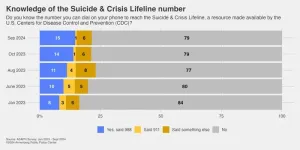(Press-News.org) Artificial intelligence is making impressive strides in its ability to read medical images. In a recent test in Britain's National Health Service, an AI tool looked at the mammograms of over 10,000 women and correctly identified which patients were found to have cancer. The AI also caught 11 cases doctors had missed. But systemic diseases, such as lupus and diabetes, present a greater challenge for these systems, since diagnosis often involves many kinds of medical images, from MRIs to CT scans.
Sheng Wang, a University of Washington assistant professor in the Paul G. Allen School of Computer Science & Engineering, worked with co-authors at Microsoft Research and Providence Genetics and Genomics to create BiomedParse, an AI medical image analysis model that works across nine types of medical images to better predict systemic diseases. Medical professionals can load images into the system and ask the AI system questions in plain English.
The team published its findings Nov. 18 in Nature Methods.
UW News spoke with Wang about the tool and about the ethics and promise of AI in health care.
What does your lab study?
Sheng Wang: We’re focused on multimodal generative AI, which means that we work to process multiple kinds of medical images. Previous research has considered only one type of image at a time — pathology images in cancer research, for instance. Our new approach is to consider all kinds of images together to predict systemic diseases. A disease like diabetes can show up all over the body — in the eyes, teeth, kidneys and so on. If you just have a model that can look at images of the eyes, it can miss things about systemic diseases.
You just published a paper with researchers from Microsoft and Providence Genomics that can process nine different kinds of medical images and translate between text and image. Companies like OpenAI and organizations like the Allen Institute for Artificial Intelligence have released AI models lately that can move between text and images. How are medical images different?
SW: When ChatGPT or Google’s Gemini model an image of a cat, for instance, that image is very small — let’s say 256 pixels across. But medical images are much larger, maybe 100,000 pixels across. If you print both images, the difference in size is the difference between a tennis ball and a tennis court. So the same method cannot be applied to medical images.
But ChatGPT is very good at understanding and summarizing long documents. So we use the same technique here to summarize very large pathology images. We break them down into many small images, each 256 by 256. These small images form something like a “sentence” of small images, but here the basic element is not a word or character — it's a small image. Then generative AI can summarize this set of small images very accurately. In May, we announced GigaPath, a model that processes pathology images using this method.
In our latest paper, we combine tools to build BiomedParse, which works across nine modalities, allowing us to incorporate models that cover CT scans, MRIs, X-rays and so on.
We found that it’s very hard to build one model that can consider all modalities because people may not be willing to share all those data. Instead, we built one model for each image type. Some are by us, some are by other experts at Harvard and Microsoft, and then we project all of them into a shared space.
We were inspired by Esperanto, a constructed language created so speakers from different countries can communicate — similar to how English functions throughout Europe now. The key idea of our BiomedParse paper is to use human language as the Esperanto for different medical imaging modalities. A CT scan is very different from an MRI, but every single medical image has a clinical report. So we project everything to the text space. Then two images will be similar not because they are both CT scans, for instance, but because they are talking about similar patients.
What are the potential applications of this tool? Would it allow general practitioners to have a better understanding of lots of different image types?
SW: Yes, it’s kind of like a search engine for medical images. It enables non-specialists to talk to the model about very specialized medical images that require domain expertise. This can enable doctors to understand images much better because, for example, reading pathology images often requires high expertise.
Even very experienced doctors can use our model to more quickly analyze images and spot subtle variations. For example, they don't need to look at every image pixel by pixel. Our model can first give some results, and then doctors can focus on those important regions. So this can make them work more efficiently, since we provide very consistent results automatically — more than 90% accuracy compared with expert human annotation — in only 0.2 seconds. Since this is a tool that detects the location of biomedical objects and counts the number of cells, 90% accuracy is often tolerable for us to correctly detect the object and predict the downstream diseases. But doctors’ guidance is still necessary to ensure that these AI tools are used properly. This is a way to augment their skills, not replace them.
Will this be available to doctors?
SW: We have already released a demo. Next, we hope to partner with UW Medicine to further develop the model and then deploy it with patients’ consent in the UW Medicine system. It's a very large effort across the UW. We’ve collected lots of data covering different regions of the human body, different modalities and different diseases. So we hope we can advance the detection of systemic diseases.
Obviously generative AI systems have various problems. Text models hallucinate information, returning wrong answers and making up facts. Image generators distort things. Are there concerns about applying this data to something as sensitive as medical imaging?
SW: We actually have another paper under submission that is specifically targeting ethical problems for generative AI in medicine. One problem is hallucination. For example, you could give a chest CT image to some AI models and ask what the dental problem is. This question doesn't make any sense, because we cannot tell dental problems from CT scans, but some existing AI models will actually answer this question, and obviously it's the wrong answer.
Another problem is ethical. We can give generative AI a dental image and ask, “What's the gender and age of this patient?” That is private information. Or you could ask it to reconstruct the person’s face. So we are working on detecting those unethical questions and making sure that the model will refuse to answer.
What is it about applying generative AI to medicine that makes you interested in it?
SW: I used to do drug discovery and genomics research with AI, but I found that that's a quite limited area, because developing a drug can take 5 or 10 years, and the most time-consuming part is testing the drug — trials in mice, trials in humans, and so on. I moved to medicine because I feel that AI is very powerful for analyzing image data and images along with text.
I’m also pursuing drug repurposing. It means that, for example, a drug used to treat retinal disease could, without being designed for other purposes, also treat heart failure. So if this drug is already being used for retinal disease and we find it’s effective for heart failure, we can immediately apply it, because we know that it’s safe. This is one of the potential zbenefits of studying systemic diseases with AI. If we find in combining retinal images with heart failure images that retinal images can predict heart failure, we might uncover such a drug. That’s a long-term goal here.
For more information, contact Wang at swang@cs.washington.edu.
END
Q&A: A new medical AI model can help spot systemic disease by looking at a range of image types
2024-11-18
ELSE PRESS RELEASES FROM THIS DATE:
For low-risk pregnancies, planned home births just as safe as birth center births, study shows
2024-11-18
CORVALLIS, Ore. – In low-risk pregnancies, mothers and children are just as safe with a planned home birth as they are with a planned birth center birth, a national study led by Oregon State University researchers has shown.
The findings, published in Medical Care, contradict doctors’ long-held concerns about home birth, including a recent opinion by the American College of Gynecologists and Obstetricians that describes hospitals and accredited birth centers as the safest places to have a baby. A birth center is a health care facility designed to provide a more natural and home-like environment than a hospital.
OSU ...
Leaner large language models could enable efficient local use on phones and laptops
2024-11-18
Large language models (LLMs) are increasingly automating tasks like translation, text classification and customer service. But tapping into an LLM’s power typically requires users to send their requests to a centralized server — a process that’s expensive, energy-intensive and often slow.
Now, researchers have introduced a technique for compressing an LLM’s reams of data, which could increase privacy, save energy and lower costs.
The new algorithm, developed by engineers at Princeton and Stanford Engineering, works by trimming redundancies and reducing the precision of an LLM’s ...
‘Map of Life’ team wins $2 million prize for innovative rainforest tracking
2024-11-18
Traditionally, taking inventory of the species in a rainforest requires sending in a team of experts with field guides and binoculars for a multi-day expedition. But the devastating pace of the destruction of the world’s rainforests and increasing urgency to better monitor and protect what remains demand faster, easier, and more efficient approaches.
Several years ago, a Yale-based team devised an alternate approach: they use lightweight, unmanned aerial vehicles (UAVs) to collect this critical biodiversity data in remote areas.
Now they’ve collected ...
Rise in pancreatic cancer cases among young adults may be overdiagnosis
2024-11-18
Embargoed for release until 5:00 p.m. ET on Monday 18 November 2024
@Annalsofim
Below please find summaries of new articles that will be published in the next issue of Annals of Internal Medicine. The summaries are not intended to substitute for the full articles as a source of information. This information is under strict embargo and by taking it into possession, media representatives are committing to the terms of the embargo not only on their own behalf, but also on behalf of the organization they represent. ...
New study: Short-lived soda tax reinforces alternative presumptions on tax impacts on consumer behaviors
2024-11-18
Key Takeaway:
When policymakers enact consumption taxes to raise revenue for the government, consumers who oppose the tax may decrease their consumption more, leading to a reduction in tax revenue.
BALTIMORE, MD, November 18, 2024 – One of the most common assumptions tax policymakers make is that by raising taxes, they will raise revenue for the government. However, a new study that centers on a soda tax in Washington state has reinforced alternative presumptions about tax impacts on consumer behaviors.
Researchers found that when Washington state enacted a tax on soda, it not only generated backlash in the consumer marketplace and political ...
Fewer than 1 in 5 know the 988 suicide lifeline
2024-11-18
PHILADELPHIA – Annenberg Public Policy Center survey data show that public recall of the 988 Suicide & Crisis Lifeline number has grown slowly since the three-digit phone number was introduced in July 2022. Just 15% of U.S. adults are familiar with it, as of September 2024.
Survey respondents who accurately report awareness of the Suicide & Crisis Lifeline number increased significantly from August 2023 (11%) to September 2024 (15%). Those 15% of respondents reported both that they knew the number and, when asked in an open-ended format, said the number ...
Semaglutide eligibility across all current indications for US adults
2024-11-18
About The Study: A total of nearly 137 million adults, representing more than half of all U.S. adults, are eligible for semaglutide therapy. This exceeds the number of adults eligible for statins (approximately 82 million), currently the most prescribed pharmaceuticals among U.S. adults.
Corresponding Author: To contact the corresponding author, Dhruv S. Kazi, MD, MS, email dkazi@bidmc.harvard.edu.
To access the embargoed study: Visit our For The Media website at this link https://media.jamanetwork.com/
(doi:10.1001/jamacardio.2024.4657)
Editor’s Note: Please see the article for additional information, including other authors, author contributions ...
Can podcasts create healthier habits?
2024-11-18
Whether it’s ABC Listen’s Health Report or Mamamia’s But Are You Happy, podcasts have fast become a part of our everyday media consumption. In fact, the average person spends more than five hours a week listening to them. But could listening to podcasts lead to healthier habits?
In the first study of its kind, University of South Australia researchers have explored just this, finding that podcasts can significantly improve health knowledge, increase exercise levels, and boost healthy eating.
Reviewing ...
Zerlasiran—A small-interfering RNA targeting lipoprotein(a)
2024-11-18
About The Study: Zerlasiran, a small-interfering RNA targeting hepatic synthesis of apolipoprotein(a), was well-tolerated and reduced time-averaged lipoprotein(a) concentration by more than 80% during 36 weeks of treatment in patients with atherosclerotic cardiovascular disease.
Corresponding Author: To contact the corresponding author, Steven E. Nissen, MD, email nissens@ccf.org.
To access the embargoed study: Visit our For The Media website at this link https://media.jamanetwork.com/
(doi:10.1001/jama.2024.21957)
Editor’s ...
Anti-obesity drugs, lifestyle interventions show cardiovascular benefits beyond weight loss
2024-11-18
Popular anti-obesity drugs continue to show cardiovascular benefits beyond weight loss, according to several new papers published in JACC, the flagship journal of the American College of Cardiology, that are being simultaneously presented at the American Heart Association’s 2024 Scientific Sessions. JACC is publishing two secondary analyses on the impact of GLP-1 medications in improving cardiac structure and function in heart failure patients and cardiovascular outcomes in those who previously had cardiac bypass surgery, ...


